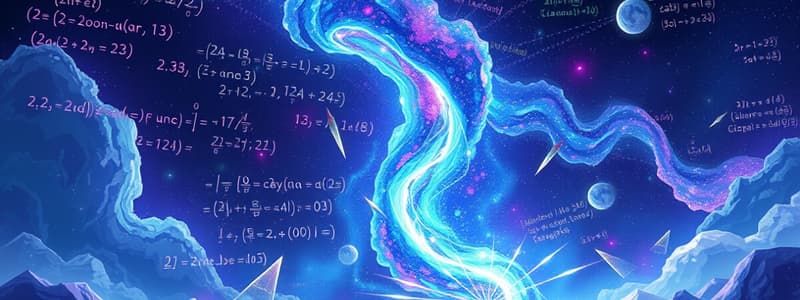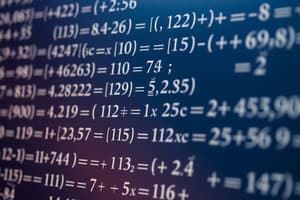Podcast
Questions and Answers
What is a variable?
What is a variable?
A symbol that can be replaced by any set of numbers or objects.
What is an algebraic expression?
What is an algebraic expression?
When numbers and variables are combined using the operations of arithmetic.
Define the term 'expression' in algebra.
Define the term 'expression' in algebra.
When numbers and variables are combined using the operations of arithmetic.
What constitutes an algebraic sentence?
What constitutes an algebraic sentence?
What does evaluating an expression involve?
What does evaluating an expression involve?
What is the Order of Operations?
What is the Order of Operations?
What is an equation in algebra?
What is an equation in algebra?
What is a formula?
What is a formula?
What does algebra represent?
What does algebra represent?
What is f(x) notation?
What is f(x) notation?
What is the argument of a function?
What is the argument of a function?
What is the value of a function?
What is the value of a function?
What is mapping notation?
What is mapping notation?
What defines a real function?
What defines a real function?
What is the domain of a function?
What is the domain of a function?
What is set-builder notation?
What is set-builder notation?
What is the range of a function?
What is the range of a function?
What are natural numbers?
What are natural numbers?
What are counting numbers?
What are counting numbers?
What are whole numbers?
What are whole numbers?
What are integers?
What are integers?
What are real numbers?
What are real numbers?
What are rational numbers?
What are rational numbers?
What are irrational numbers?
What are irrational numbers?
What is the rate of change?
What is the rate of change?
What defines the slope of a line?
What defines the slope of a line?
What is the y-intercept?
What is the y-intercept?
What is a linear function?
What is a linear function?
What is the slope-intercept form?
What is the slope-intercept form?
What is the x-intercept?
What is the x-intercept?
What is a linear combination?
What is a linear combination?
What is standard form?
What is standard form?
What is point-slope form?
What is point-slope form?
What is a piecewise linear function?
What is a piecewise linear function?
What is linear regression?
What is linear regression?
What are lines of best fit?
What are lines of best fit?
What is deviation?
What is deviation?
What is a recursive formula?
What is a recursive formula?
What is the Fibonacci sequence?
What is the Fibonacci sequence?
What defines a linear sequence?
What defines a linear sequence?
What is a system in algebra?
What is a system in algebra?
What is the solution to a system?
What is the solution to a system?
What is the substitution method?
What is the substitution method?
What is a consistent method?
What is a consistent method?
What is an inconsistent method?
What is an inconsistent method?
Flashcards are hidden until you start studying
Study Notes
Variables and Expressions
- Variable: A symbol representing numbers or objects; used in algebraic expressions.
- Algebraic Expression: Combination of numbers and variables using arithmetic operations.
- Expression: Similar to algebraic expressions, combining numbers and variables with arithmetic.
- Algebraic Sentence: Contains expressions linked by a verb in symbolic form.
Evaluations and Operations
- Evaluating an Expression: Involves substituting variables with numbers and calculating results.
- Order of Operations: Governed by PEMDAS (Parentheses, Exponents, Multiplication and Division, Addition and Subtraction) and evaluated left to right.
Equations and Formulas
- Equation: A statement asserting that two expressions are equal.
- Formula: Specifies a relationship where a variable equals an expression involving other variables.
Functions and Notation
- f(x) Notation: Represents a function of x.
- Argument of a Function: The value contained within the parentheses of a function.
- Value of a Function: Corresponds to the value assigned to x in a function.
- Mapping Notation: Represents functions using arrows or columns.
Function Properties
- Real Function: Functions where variables represent real numbers.
- Domain of a Function: Set of allowable values for the independent variable.
- Set-Builder Notation: A concise way to define a set, e.g., {x | b ≤ x ≤ z}.
- Range of a Function: Set of allowable values for the dependent variable.
Number Sets
- Natural Numbers: Counting numbers starting from 1 to infinity.
- Whole Numbers: Natural numbers and zero.
- Integers: All whole numbers, both positive and negative, extending to infinity.
- Real Numbers: Any value represented by decimals.
- Rational Numbers: Numbers that can be expressed as a fraction of two integers.
- Irrational Numbers: Numbers that cannot be expressed as a fraction.
Graphing and Lines
- Rate of Change: Often represented as slope in graphs.
- Slope: Numeric representation of the steepness of a line (change in y/change in x).
- Y-Intercept: The point where a graph intersects the y-axis.
- Linear Function: A function whose graph forms a straight line.
- Slope-Intercept Form: The equation of a line in the form y = mx + b.
- X-Intercept: The point where a graph crosses the x-axis.
Linear Forms
- Linear Combination: Expression where all variables are first power; involves multiplication/division.
- Standard Form: An equation written as Ax + By = C.
- Point-Slope Form: Represents a line through a point (x1, y1) with a slope m as y - y1 = m(x - x1).
- Piecewise Linear Function: Graph depicted in different sections.
Data Analysis
- Linear Regression: A statistical method to find the best-fitting line through data points.
- Lines of Best Fit: Result of linear regression indicating the general trend of the data.
- Deviation: The difference between actual values and values predicted by a model.
Sequences and Systems
- Recursive Formula: Describes a sequence by stating the first term and how to derive subsequent terms.
- Fibonacci Sequence: A series in which each number is the sum of the two preceding ones.
- Linear Sequence: A numerical sequence with a constant difference between terms.
- System: A combination of equations recognized by the term "and."
- Solution to a System: The intersection of the solution sets of the equations involved.
Methods for Solving Systems
- Substitution Method: Allows one variable to be replaced with another as long as they are equal.
- Consistent Method: Indicates the system has one or more solutions.
- Inconsistent Method: Indicates the system has no solutions.
Studying That Suits You
Use AI to generate personalized quizzes and flashcards to suit your learning preferences.



